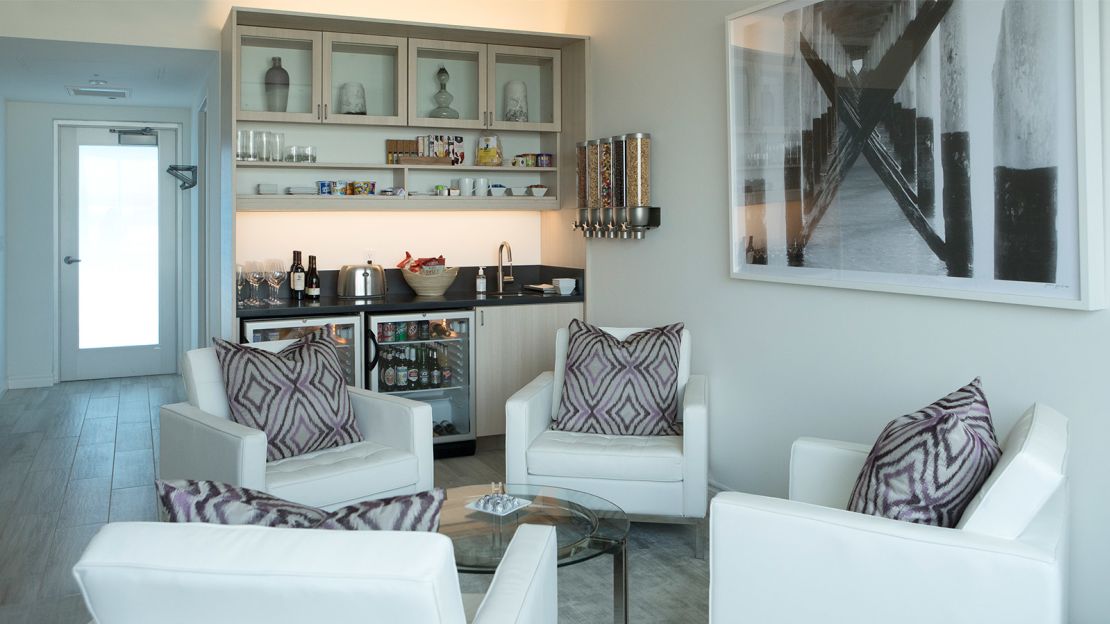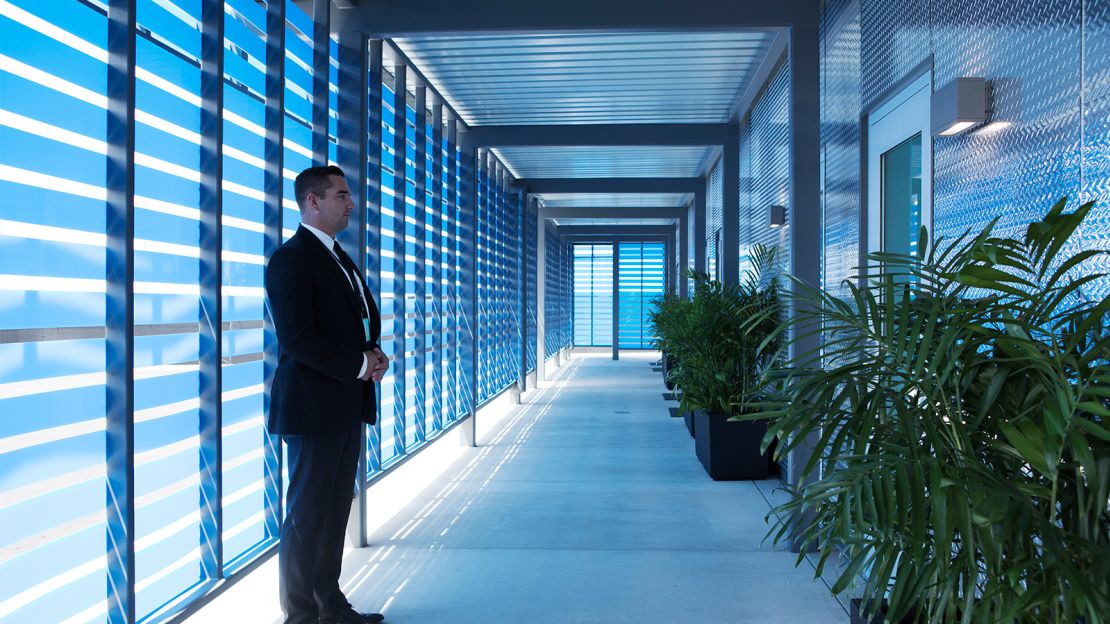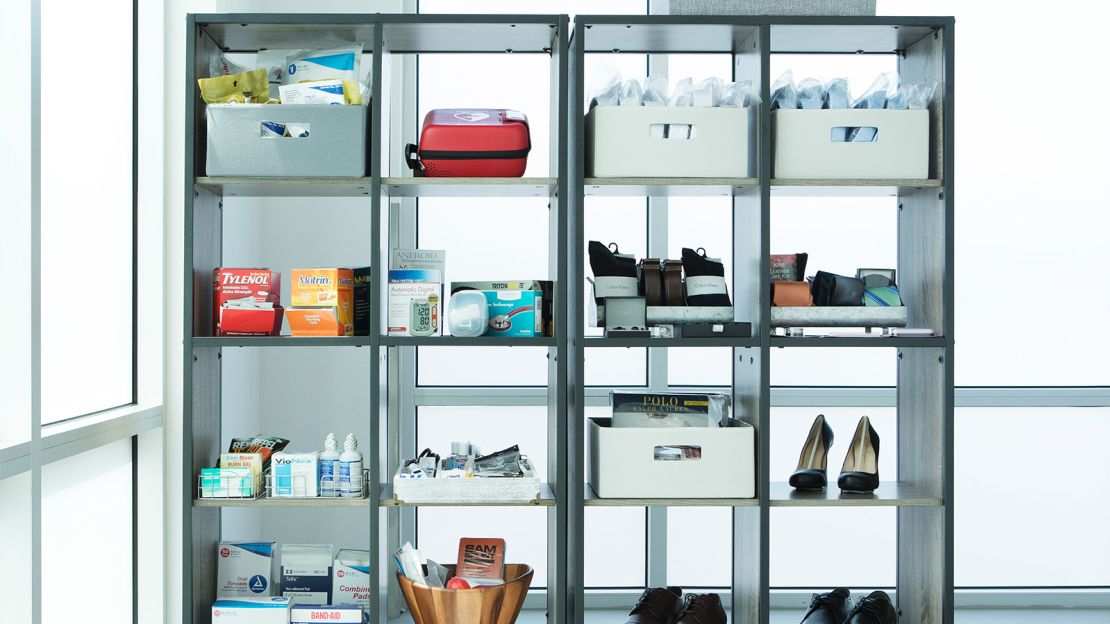Most of us are not VIPs.
For the majority, several hours of boredom and misery stand between us and our dream vacation, navigating the drive to the airport, then inside the terminal there’s the kiosks, the baggage areas, TSA, Cinnabon and a bottle of water that costs enough to affect your FICO score.
But if you’re a VIP, and you have the wherewithal, at Los Angeles International Airport there’s another option.
Behind the velvet rope

If you’re a member of the elite, rather than join the crowds on the 405 heading to the main entrance, you take the appropriately named Imperial Highway along the southern border of LAX. Passing by a series of nondescript airport buildings, you’ll see a sign with a discreet logo of a door and some swishy lines.
Having made your reservation earlier, the guard at the security booth will check your ID and then open two 10-foot steel doors that are painted battleship gray and move with all the portent of the gates to a secret lair.
Because that’s what this is. The Private Suite at LAX is a separate, reservation-only passenger terminal for all commercial flights at the airport.
For a price, you can step into an alternate reality, one with your own room to relax in while waiting for your flight, private security screening, and a chauffeur-driven ride across the tarmac to your waiting plane.
The Private Suite opened in May 2017, the brainchild of Gavin de Becker, a private investigator/security consultant to the stars.
What used to be a cargo facility has been transformed into 11 private rooms, each around 250 square feet. The rooms are arranged alongside the parking lot, like a motel.
That means there are no common areas for you to, you know, run into anyone. Discretion is the name of the game here.
The rooms are tastefully appointed in the muted shades of a luxury aesthetic that is more correct than daring. Comfortable easy chairs and couches furnish the room, as does a large television, an en suite powder room and wet bar.
From the window at the far end of the room, you can see various international jets lined up at their gates, their tail plumage battling for supremacy.
While you wait, you can eat, drink and groom yourself to your heart’s content, thanks to the well-stocked shelves, refrigerator and bathroom.
Bottles of not-crappy wine (Stag’s Leap Cabernet, Sokol Blosser Pinot Noir, splits of Pommery champagne) and spirits are accompanied by artisanal chocolates that are several steps above a Whitman’s Sampler, good fresh fruit (we’re talking organic Honeycrisp apples, people, not that Red Delicious dreck) as well as boxes of cereals and wall-mounted dispensers of candy and pretzels.
In the bathroom, you’ll find Kiehl’s toiletries, as well as just about anything you might have forgotten to pack: shave cream, Tide pens, Advil, deodorant, Immodium and a lint roller. The living room also has sundries for the last-minute traveler (international chargers, power cables, neck pillows).
But what about TSA checkpoints and customs?

All of this is free.
Well, all of this is “included,” because the Private Suite’s largesse is predicated on the largesse of you paying to use it.
The annual membership fee is $7,500, and each trip you take costs an additional $2,500 for domestic voyages and $3,000 for international jaunts.
That money gets you something far more valuable than just a private room.
When it’s time to board the plane, you proceed to a private, dedicated TSA checkpoint on the property. Three uniformed agents check your ID and process you and your carry-ons through the usual X-ray machines.
Per Private Suite policy, only one guest party is at the checkpoint at one time, so there’s never a line. You never see anyone other than Private Suite staff and TSA employees.
On the other side of security, a minifridge has bottles of Voss water for you to take on your flight.
Your attendant then guides you to a waiting 7-Series BMW. Settling into the back seat, you’re driven for roughly 15 minutes across the taxiways and landing strips of LAX (the distance traveled isn’t long, but LAX imposes a 20 mph speed limit on any vehicle near planes, so it’s a drive more stately than swift).
You’re driven directly to your plane, which you board by ascending the exterior staircase that deposits you right in front of the main cabin door.
Depending on your preference/level of fame, you can schedule your arrival here so that you’re first on board or, if you don’t want commoners passing you on their way to steerage, the last to arrive.
The process when you land at LAX from elsewhere is similar: An attendant will be waiting for you at the main cabin door when you step into the Jetway.
You exit via the stairs used to gate check baby strollers and such, and you pop back into the BMW to be returned to the Private Suite. Any checked baggage will be retrieved and follow you back to the suite, usually in a few minutes.
There is a private shower suite if you need to refresh – the large bathroom has a spacious changing area and an equally roomy walk-in shower, replete with products from Kiehl’s and Malin+Goetz.
On-site customs and immigration officers can process any baggage or passports right at the Private Suite. If you drove to the suite when you departed, your car will be brought around, waiting for you right outside your room.
Who on earth can afford this?

Not surprisingly, this is all very nice. But the question – aside from “Is this what Late Capitalism looks like right before it collapses?” – is, “Who is this for?”
In this case, The Private Suite is cutting the affluence onion into ever-thinner slices, which may be smart.
Think of it this way: If you are a Registered Fancy Person, it’s not unreasonable to think you may fly 20 times a year. And if we posit that a dozen of those flights are domestic and eight are international, then using the Private Suite, each year, would cost you $61,500.
That is both a lot and not a lot of money. It’s a lot of money to, well, most everyone in the world, but to one group, it’s not.
According to the World Wealth Report, there are approximately 226,000 individuals worldwide possessing liquid assets in excess of $30 million.
That group includes, of course, billionaires, who are likely to skip LAX and fly in and out of private airports on their own jets.
But when you start to look closely at modern-day Croesuses, a strange rationale comes into focus: Private-jet ownership remains wildly expensive.
A Gulfstream G650 can easily cost $70 million, and that’s without you spending any money to furnish it – a cost that can double that pricetag. Even smaller jets cost in the seven and eight figures.
Fractional ownership? Sure, it’s less expensive, but even a light jet (which is not as comfortable as First Class on a big commercial widebody, nor can it travel as far without refueling) can run $5,500 per hour of flight.
All of a sudden, a single round-trip flight from New York to LA starts to run $66,000, minimum.
In that light, The Private Suite is a bargain. The Private Suite has likely crunched these same numbers and determined there’s a market, as the company is looking to expand to other airports: JFK is next, followed by Miami, Las Vegas and London.
There’s an oft-cited exchange between F. Scott Fitzgerald and Ernest Hemingway; it didn’t really happen the way it’s described, but that doesn’t mean it wasn’t ringing through our head while being whisked in and out of LAX with the frictionless grace of someone better accustomed to traveling by sedan chair.
“The rich are different than you and me,” Fitzgerald once said. “Yes,”’ Hemingway replied, “they have more money.”












